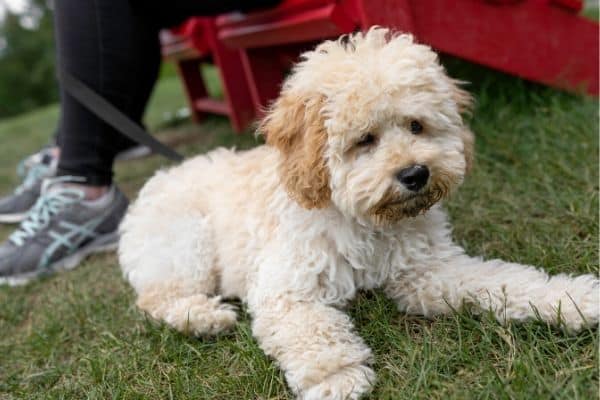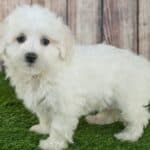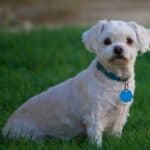Many people toying with the idea of adding a dog to their lives do not relish the thought of fur drifting through their house and settling on their floors, furniture, and clothing.
If you’re looking for a small dog who won’t have you vacuuming several times per day and lint-rolling your outfits before you leave the house, a Maltipoo may be just what you are looking for.
Averaging between 7 – 14 pounds, Maltipoos may be small in stature but are big in the personality, intelligence, and affection departments. This designer dog, as the name suggests, is a combination of a Maltese and a Poodle, both of whom are known for being low shedders and great companion animals.
So, how does their offspring, the incredibly cute Maltipoo, rank when it comes to shedding tendencies?
Do Maltipoos Shed? All dogs shed to some degree, but Maltipoos are considered to be very low shedders. In fact, they were originally created with allergy sufferers in mind. Litters resulting from a Maltipoo being bred to a Poodle typically exhibit the least amount of shedding.
Let’s take a closer look at the Maltipoo’s shedding tendencies, see if they are a good fit for those with allergies, and learn about their grooming needs.
How Much Do Maltipoos Shed?
We hate to be the bearer of bad news, but all dogs do shed to some degree. No dog keeps the same set of hairs throughout his lifetime.
The coat naturally pushes out the older, brittle hair and replaces it with new growth. This cycle of replenishing the coat and the subsequent shedding of hair can vary dramatically from breed to breed and even in dogs of the same breed.
Because Maltipoos do not have an undercoat, they will not experience heavy seasonal shedding like double-coated dogs do. You may notice a slight increase in shed hair during particularly hot summers, but the difference will be negligible.
When it comes to year-round shedding, you can expect a Maltipoo to shed very lightly. A few hairs will be lost here and there as the coat cycles through its growth phases, but the amount of shed hairs found sprinkled around your home will be minimal.
A Maltipoo’s genetics and pedigree dictate whether his shedding will be practically nonexistent or minimal.
[mv_video doNotAutoplayNorOptimizePlacement=”false” doNotOptimizePlacement=”false” jsonLd=”true” key=”yahuwlonb1dselzhwqio” ratio=”16:9″ thumbnail=”https://mediavine-res.cloudinary.com/v1607521240/z6c6mi29ecupjy8dg0dd.jpg” title=”Meet 6 Adorable Maltipoos” volume=”70″]
Genetics
The breeding of a purebred Maltese and a purebred Poodle results in a litter of puppies with varying degrees of shedding. Some pups may inherit their coats from their Maltese parent and will therefore shed minimally.
Other puppies may wind up with a Poodle-like coat and hardly shed at all. Some will be a nice combination and fall somewhere in the middle.
Pedigree
Maltipoos who have been bred back to a Poodle will produce puppies with a heavier concentration of Poodle genes. The more this backcrossing has occurred in your Maltipoo’s family tree, the more likely it is that shedding will be nearly nonexistent.
Certain Situations Can Cause More Shedding
A drastic, sudden change in the amount of shed hair is a cause for concern and necessitates a trip to your veterinarian. Possible causes of abnormal hair loss include:
- Flea allergy.
- Hypothyroidism.
- Malnutrition.
- Allergic dermatitis.
- Alopecia.
- Mange – either sarcoptic or demodectic.
- Aconthosis Nigrican.
Routinely stressed Maltipoos (like those suffering from separation anxiety) may experience a condition known as neurodermatitis. In these cases, the anxious dog will compulsively lick himself, wearing away the coat and irritating the skin until it is raw and prone to infection.
If you suspect that your Maltipoo has an underlying condition causing an increased amount of shedding, please don’t hesitate to notify your veterinarian before a small issue becomes a major ordeal.
Are Maltipoos Hypoallergenic?
Many people misunderstand the term hypoallergenic and assume that a dog who is often labeled as such will not produce any allergic reactions at all or shed. Both of these assumptions are inaccurate.
Allergic reactions are actually caused by proteins found in a dog’s dander (dead skin cells), saliva, and urine, so an extremely allergic person may have an allergic reaction to any dog.
Mirriam-Webster defines hypoallergenic as, “having little likelihood of causing an allergic response.” So, a dog breed that is termed hypoallergenic is much less likely to trigger allergies, but it is not a sure thing.
Why is the term “low shedding” associated with being hypoallergenic? While dog hair is not what triggers allergic reactions, the allergens from the dander, saliva, and urine often cling to the hair.
So, the less that a dog sheds, the fewer allergens are spread throughout the house.
Both of a Maltipoo’s parent breeds, the Maltese and the Poodle, tend to not produce much dander and are known to be hypoallergenic, particularly the Poodle. The proteins found in their dander, saliva, and urine differ enough from other dogs that these breeds are often well tolerated by allergy sufferers.
Now you can see why breeders thought to put these two breeds together when they were looking to create a small, new, adorable crossbreed with a double dose of low-shedding tendencies for people unable to tolerate most dogs.
In answer to the question, yes, Maltipoos are considered to be hypoallergenic.
When Do Maltipoos Shed Their Puppy Coat?
A Maltipoo’s soft puppy coat will gradually begin to be replaced with a slightly stiffer adult coat beginning around the age of 10 months.
The process may take place rather quickly in some Maltipoos, and an increase in shedding may be noticed as the puppy coat is lost. Other Maltipoo may not completely transition to an adult coat until closer to their second birthday.
With these dogs, the transition is so gradual that many owners may not even notice the change and will not see an increase in the amount of shed hair.
If your Maltipoo’s pedigree includes one or more backcrosses to a Poodle, you may notice a slight change of texture and either a lightening or deepening of color as his adult coat comes in. Maltipoos who hail from a Maltese-heavy line typically will not notice any significant changes to the coat.
Maltipoo Grooming Requirements
Even though Maltipoos will not shed very much, routine grooming is still necessary and beneficial. The one aspect of grooming that should be performed most frequently is brushing.
Regardless of if the coat is wavy, curly, or mostly straight, brushing your Maltipoo several times per week should not be neglected.
Brushing:
- Should be a pleasant experience for both you and your dog.
- Is an ideal opportunity to check for injuries, cuts, hot spots, parasites, etc.
- Keeps the coat in top condition.
- Removes shed hairs before they become matted within the coat or sprinkled around the house.
- Increases blood circulation to the surface of the skin.
- Distributes protective oils evenly throughout the coat, keeping it healthy, glossy and strong.
An arsenal of fancy tools isn’t required to get the job done. A standard double-sided pin and bristle brush will do just fine for most Maltipoos. Gently work through the entire coat, checking carefully for mats especially in high friction areas like beneath the collar and behind the ears.
A quality detangling spray can make dealing with mats easier and leave the coat soft and silky.
Clipping the coat isn’t necessary, but is an option during the hot summer months. Hair surrounding the eyes and mouth may need trimming every month or so to keep the facial area clean.
A bath with a gentle, pH balanced shampoo for dogs may be given if your Maltipoo’s coat becomes dirty, but remember that over-bathing will lead to dry, itchy skin. Once a month or so should be plenty to keep the coat looking great.
Thanks to the Maltese side of the family, tear stains may be an issue for Maltipoos. If tear stains under the eyes are still present after a bath, try applying baking soda to the area and brushing clean with a toothbrush, or use pre-soaked tear stain remover pads.
We talk all about how to remove and prevent tear stains in this article.
Just like with other breeds, Maltipoos will need to have their nails trimmed once a month or so, their ears cleaned regularly, and their teeth brushed at least 2 -3 times per week.




